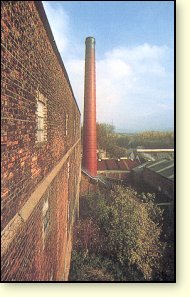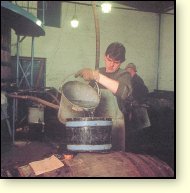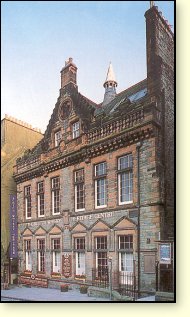
 |
|
Location: Pencaitland, East Lothian EH34 5ET
Roads: Off the A6903, off the A68 Edinburgh to Jedburgh
Hours: 9.00 - 4.00pm, Mon - Fri and Sat/Sun April - October
Group bookings by appointment
Reception centre, shop and exibition
Phone: 01875-340451
|
Text from The Whisky Trails, Copyright © Gordon Brown 1993:
East Lothian has been something of a punchbag over the centuries; it lies on the route that invading English armies tended to favour and the open rolling countryside made it useful for battle when the Scottish forces rallied in defence. Places like Haddington have been burned many times by visiting generals and Berwick changed hands between the two countries so often that today the town is in England while the county is in Scotland.

All the equipment used in the distillery has to be kept clean to ensure that no extraneous flavours taint the spirit.
|
There is just a frisson of an impression that you have gone back a little in time when you drop into the green dell that contains Glenkinchie. The baize-smooth bowling green and inviting little pavilion are just as they would have been years ago when they formed the social centre for the families of the distilling community hidden in the gentle hills behind Edinburgh. The ‘kinchie’ element of the name derives from the de Quincey family, who owned the land hereabouts in the 14th century and the Kinchie Burn still flows through the distillery.
The top-grade barley grown in the Lothians is the direct legacy of the Society of Improvers of Knowledge of Agriculture, a revolutionary 18th-century body that put Scotland in the forefront of the European farming scene at the time. The society was founded by John Cockburn of the village of Ormiston just across the fields from Glenkinchie, whose whisky production began as a part-time operation on the Rate brothers’ farm near Pencaitland. From 1825 the distillery was called Milton and in 1837 the name was changed to Glenkinchie. The next owner of the farm did not distil and the buildings became a sawmill, but whisky production began again in 1881. In the 1890s the distillery was rebuilt and became a founder company of the DCL, forerunners of today’s owners, United Distillers.

The low, open-plan building that used to be the floor maltings at Glenkinchie now houses the Museum of Malt Whisky Production.
|
The old maltings is now the Museum of Malt Whisky Production, with an excellent collection of old and traditional implements and tools that were used in Scottish distilleries. There are barley-scoops on wheels that look like dolls’ prams; espadrille-like canvas boots that maltmen wore to walk about without damaging the malt on the floor; and many other fascinating artefacts. Many were ingeniously thought out, like the copper ‘dogs’ – containers that were used to smuggle stolen spirit out of the distillery. Some were simple tubes slim enough to be dipped and filled through the bung-hole of a cask and then hung by a piece of string inside a trouser-leg on the way out from work; others were more elaborate, such as the breastplate shaped to the curve of a torso and double-skinned like a hot-water bottle, which could be hung under a shirt with string tied around the carrier’s neck.
There is a single pair of large stills, each with sighting windows to double-check, if need be, what stage the boiling has reached. In the past, a wooden ball used to hand on the still from a piece of string; when swung against the side of the vessel, the note indicated to an experienced ear how full or empty it was. The stills have unusually angled lyne-arms at the top of thickish necks. A rather unusual worm-tub is still used to condense the spirit: it is two storeys high, the tub is cast-iron and the worm itself is a rectangular spiral instead of the customary circular shape.
In horse-and-cart days, majestic large-hoofed Clydesdales pulled the dray-carts at DCL distilleries all around the country. Those that worked in Glasgow used to be sent to Glenkinchie for their ‘summer holidays’, where they could canter and amble without the restriction of the carts. In the 1950s, the manager also ran the Glenkinchie beef herd which won the fatstock Supreme Championship at Smithfield, Birmingham and Edinburgh in three successive years, plus many other individual show championships. What an advertisement for the quality of the cattle feeds made from the malting and mashing processes!
The Whisky
Text from The Whisky Trails, Copyright © Gordon Brown 1993:
Glenkinchie is light, soft, round and sweetish, although it is drier than most other Lowland malts. Some smoke, nutmeg and bite. It is issued at 10 years and 43% vol., but there are some vintages from the 1970s available from independents.
Source of water
Lammermuir Springs
Of interest
Text from The Whisky Trails, Copyright © Gordon Brown 1993:

The Scotch Whiskey Heritage Centre in Edingburgh gives little hint of the exiting displays depicting the history and production of the spirit.
|
• The Scotch Whisky Heritage Centre in Edinburgh’s Royal Mile below the Castle has the sights, sounds and smells of the history of whisky production. You move in a whisky-barrel car through tableaux from history, with commentary available in seven different languages.
• Drambuie Liqueur is produced and bottled at Kirkliston. The story of its origins is a romantic one, involving Bonnie Prince Charlie and a Skyeman, John Mackinnon, descendants of whom still run the company. Visit the plant to hear more and watch how the liqueur is made. Tel: 0131-333 3531 for details.
• Visit the plant that produces Glayva Liqueur – Edinburgh’s other international whisky liqueur. Tel: 0131-554 4404.
• Winton House near Haddington is a masterpiece of Scottish Renaissance architecture. Fine furniture, ornate ceilings and intricate stone carvings.
• The Heritage of Golf Museum at Gullane has a good collection of golfing memorabilia. Ask them if golf really did originate in Scotland and not in Holland, as some evidence now seems to show.
• The Museum of Flight at East Airfield has an extensive aircraft collection and displays of the history of flight. New Zealanders still think their own man, Richard Pearse, beat the Wright brothers to it; he just didn’t bother to write down the date of his flight at the time!
• The Scottish Mining Museum at the former Lady Victoria colliery has ex-miners as guides. They tell the story of a site that has been mined for 800 years.